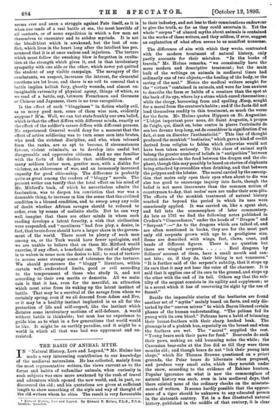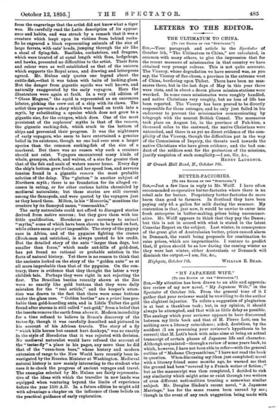THE BASIS OF ANIMAL MYTH.
IN Natural History, Lore and Legend,"* Mr. Hulme has made a very interesting contribution to our knowledge of the mediaeval naturalists. He bas collected, mainly from the most representative writers, the views current as- to the forms and habits of unfamiliar animals, when curiosity in such subjects was once more awakened by the rush of travel and adventure which opened the new world, and, in part, re- discovered the old ; and his quotations are given at sufficient length to show something of the style and way of thought of the old writers whom he cites. The result is very favourable • Natuull Bio.ori, Lore and Legend. By Edward P. HnIrce, F.L.S., F.S.A. London: Quaritch
to their industry, and not less to their conscientious endeavour to give the truth, so far as they could ascertain it. Yet the whole " corpus " of absurd myths about animals is contained in the works of these writers, and they seldom, if ever, suggest an explanation of what often seems to us manifest nonsense.
The difference of aim with which they wrote, contrasted with the modern treatment of natural history, only partly accounts for their mistakes. " In the books of travels," Mr. Hulme remarks, "we occasionally have the more modern and descriptive treatment ; but the main bulk of the writings on animals in mediaeval times had ordinarily one of two objects,—the healing of the body, or the saving of the soul." Hence the medical writers sought for the " virtues " contained in animals, and were far less anxious to describe the form or habits of a creature than the spot at the back of its eye, where lay a stone which cured rheumatism ; while the clergy, borrowing from and spoiling 2Esop, sought for a moral from the creature's habits ; and if the facts did not lend themselves readily to this treatment, so much the worse for the facts. Mr. Hulme quotes Hippean on St. Augustine. "L'objet important pour nous, dit Saint Augustin, 3 propos de l'aigle, qui, disait on, brise contre la pierre l'extremite de son bee devenu trop long, eat de considerer la signification d'un fait, et non en discuter l'authenticite." This line of thought produced the monkish " bestiaries," which gave a kind of credit derived from religion to fables which otherwise would not have been taken seriously. To this class of animal myth belong the greater number of beliefs in " antipathies " between certain animals—in the feud between the dragon and the ele- phant, though this may possibly be based on stories of elephants being attacked by crocodiles when drinking, and that between the polypus and the lobster. The moral carried by the assump- tion that moles only open their eyes when about to die was also too good to encourage inquiry into facts, though the belief is not more inaccurate than the common notion of countrymen to-day, that moles' ears are under their arm-pits. The effects of the monkish treatment of natural history reached far beyond the period in which its uses were consciously applied. It was carried on, like a spent shot, and fell into the commonplace of later commentary. As late as 1761 we find the following notes published in Cruden's "Concordance," under the heads of "Dragon" and " Serpent " :—" As to the dragons which are talked of, and are often mentioned in books, they are for the most part only old serpents grown with age to a prodigious size. Some are described with wings, feet, claws, crest, and heads of different figures. There is no question but there are winged serpents Real dragons, by Solimus' account of them, have a small mouth and can- not bite ; or, if they do, their biting is not venomous." "It is further said of the serpent's subtilty, that it stops up its ears that it may not hear the voice of the charmer. It is said that it applies one of its ears to the ground, and stops up the other with the end of its tail. Others say that the sub- tilty of the serpent consists in its agility and suppleness ; or in a secret which it has of recovering its sight by the use of fennel."
Beside the impossible stories of the bestiaries are found another set of " myths " mainly based on facts, and only dis- torted by the " uneven mirror" to which Bacon likened certain phases of the human understanding. "The pelican fed its young with its own blood." Pelicans have a habit of trimming their breast-feathers with their sharp hooked beak. The plumage is of a pinkish hue, especially on the breast and when the feathers are wet. The "moral" supplied the rest. " Young bears suck their paws for food." Bear-cubs do suck their paws, making an odd humming noise the while ; the Caucasian bear-cubs at the Zoo did so till they were three months old ; and though bears do not "lick their young into shape," which Sir Thomas Browne questioned on a priori grounds, the Polar bears do hibernate when pregnant, and produce very small cubs, which they nourish under the snow, according to the evidence of Eskimo hunters. Popular ignorance on what is now the commonplace of natural history was such, even in late mediaeval days, that there existed none of the ordinary checks on the misstate- ments of writers. It seems hardly possible that the appear- ance of a tiger should be unknown to any educated person in the sixteenth century. Yet in a fine illustrated natural history, published in the middle of that century, it is clear
from the engravings that the artist did not know what a tiger was. He carefully read the Latin description of its appear- ance and habits, and was struck by a remark that it was a creature which leapt upon its victims from behind rocks. So he engraved a block representing animals of the size of large ferrets, with cats' heads, jumping through the air like a shoal of flying-fish. Basilisks, cockatrices, and dragons, which were treated of at equal length with fleas, hedgehogs, and hawks, presented no difficulties to the artist. Their form and colour were as well established as that of the unicorn which supports the Royal arms, and drawing and letterpress agreed. Mr. Hulme only quotes one legend about the extttle-fish,--that it was taken with baits of looking-glass. But the danger from gigantic squids was well known, and naturally exaggerated by the early voyagers. Here the illustrators were again at fault. In a very old edition of " Olaus Magnus," the squid is represented as an enormous lobster, picking the crew out of a ship with its claws. The artist thus perverts a story which was based on truth into a myth, by substituting a species which does not grow to a gigantic size, for the octopus, which does. One of the most persistent of the explorers' myths is that of the remora, the gigantic sucking-fish, which stuck to the bottom of ships and prevented their progress. It was the nightmare of early voyagers, who seem to have entertained a genuine belief in its existence, though no one had ever seen a larger species than the common sucking-fish of the size of a mackerel. But there was no reason why such a creature should not exist. Voyagers encountered many kinds of whale, grampus, shark, and walrus, of a size far greater than that of the fish and seals of waters nearer home. Every day the ship's bottom grew fouler, and her speed less, and nervous tension found in a gigantic remora the most probable solution of the delay. The "glutton" is another subject of Northern myth ; there is no foundation for its alleged ex- cesses in eating, or for other curious habits chronicled by mediaeval naturalists; but these stories are still current among the Samoyeds, and were quoted by the voyagers just as they heard them. Milton, in his " Moscovia," mentions the creature by its Samoyed name, "rossomakka."
The early naturalists could not afford to disregard stories derived from native sources ; but they gave them with too little qualification. Herodotus gave currency to animal "myths," some of which have been shown to be based on fact, while others seem a priori impossible. The story of the pygmy race in Africa, and of the pygmies fighting the cranes (Bush-men and ostriches), is always quoted to his credit. But the detailed story of the ants "larger than dogs, but smaller than foxes," which made ant-hills of gold-dust, bas yet found no rational or probable solution in the facts of natural history. Yet there is no reason to think that the ancients looked on the story of the " golden ants" as at all more improbable than that of the pygmies. On the con- trary, there is evidence that they thought the latter a very childish tale. Perhaps they were right in not rejecting the first. The Brazilian beetles recently shown at the Zoo were so exactly like gold buttons that they were daily mistaken for the " real article," and the keeper's atten- tion was drawn to the fact that there were some buttons under the glass case. " Golden beetles" are a priori less pro- bable than gold-hoarding ants, and in Little Thibet the gold found after storms is still called " ant-gold," from a belief that the insects remove the earth from above it. Modern incredulity for a time refused to believe in Bruce's discovery of the tsetse-fly, though it was carefully described and pictured in his account of his African travels. The story of a fly 4‘ which kills horses but cannot hurt donkeys," was so exactly in the style of Herodotus that it was rejected with derision. No mediaeval naturalist would have refused the account of the "tsetse-fly" a place in his pages, any more than he did that of the "oxen-born bees," whose history and modern extension of range to the New World have recently been in- vestigated by the Russian Minister at Washington. Medieval natural history is now mainly interesting to the student who uses it to check the progress of ancient voyages and travel. The examples selected by Mr. Hulme are fairly representa- tive of the ideas with which the traveller in new lands was equipped when venturing beyond the limits of experience before the year 1500 A.D. In a future edition he might add with advantage a chapter on the influence of these beliefs on the practical guidance of early exploration.



















































 Previous page
Previous page